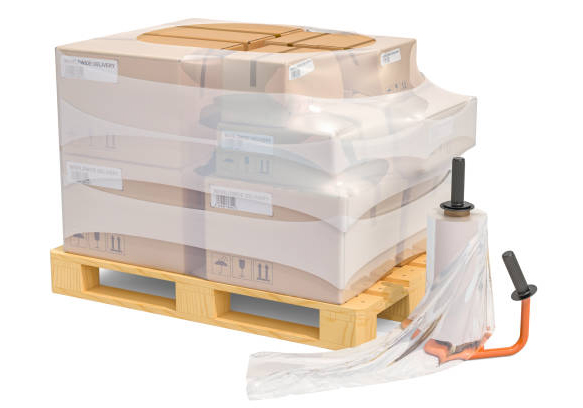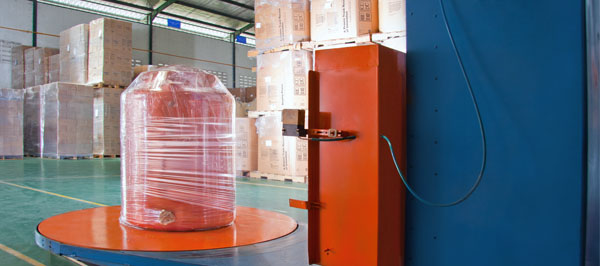When it comes to wrapping pallets, using traditional stretch wrap methods can be tedious and time-consuming. With the advent of machine stretch film technology, however, businesses are reaping several benefits that make the process easier and more efficient. Not only does this type of film provide superior protection for products, but it also offers many other advantages to users.
These are just some of the many benefits of using machine stretch film:
Cost savings
Speed
Versatility
Strength
Environmental friendly

Viscosity control is an important part of stretch film production as it affects the efficiency and quality of the finished product. With a few simple adjustments, stretch wrap machine operators can take control of viscosity and improve their output significantly.
This article will discuss what machine stretch film is all about, including its role in the packaging industry, benefits, and some factors that control its viscosity.
Definition of machine stretch film
Machine stretch film is made from linear ultra-low density polyethylene (LLDPE) which allows it to be stretched up to 200% of its original length. This gives the film an increased load-holding capacity and containment strength, making it ideal for bundling products together. Machine stretch film also features a high puncture resistance due to its multi-layer construction which makes it capable of withstanding mechanical wear and tear. The cling properties of machine stretch film help keep items from shifting during transportation, providing added protection against possible damage. Furthermore, this type of stretch wrap is easily applied using automated stretch wrapping machines, making them a cost-effective option for large-scale operations. With its superior durability and strength, machine stretch film offers exceptional value for businesses looking for a reliable packaging solution.
Overview of viscosity
Machine stretch film is classified as a thin and stretchable plastic film, which is characterized by its strong elasticity and cling. This type of film also exhibits high viscosity, meaning that it resists flow due to internal friction between the molecules of the material. The viscosity of machine stretch film increases with temperature and decreases when exposed to solvents. Additionally, the level of viscosity can be adjusted through compounding techniques such as increasing or decreasing the number of additives included in the polymer blend.
High levels of viscosity are essential for machine stretch wrap because it provides greater strength during the application, reducing the risk of tearing or punctures while in use. This increased strength also allows for heavier loads to be secured with fewer wraps, resulting in cost savings during the packing process. Furthermore, the high viscosity of machine stretch film contributes to improved load stability and integrity, immune to the effects of dust or moisture.

Role of Machine Stretch Film
Uses of machine stretch film
Machine stretch film is particularly useful for bundling and unitizing multiple items together. It provides an efficient, cost-effective, and reliable method of securely containing various products. This type of packaging can help ensure that the goods remain stable during shipping, storage, and handling. Additionally, machine stretch film can be used to protect products from dirt, moisture, dust, and other elements that may degrade them during transportation. Furthermore, this form of packaging offers excellent load containment which helps reduce product loss due to shifting or falling objects during transit. By properly utilizing automatic stretch wrappers in the packaging process, businesses can minimize the costs associated with rework due to damage caused by inadequate packing techniques. With its versatility, strength, and cost-effectiveness, machine stretch film is a valuable asset for businesses in many industries.
Benefits of using machine stretch film
Here are just a few of the benefits that come with using machine stretch film on your pallet wrapping operations.
- Cost savings: Machine stretch film is a much more economical way to wrap pallets. It takes less time and labor to wrap a pallet with machine stretch film than it does with other methods, resulting in significant cost savings.
- Speed: Wrapping pallets with machine stretch film is much faster than traditional methods. Some machines are capable of wrapping pallets in as little as 15 seconds. This increased speed allows businesses to complete more pallet wrapping tasks in less time, allowing them to get back to their other business operations faster.
- Versatility: Machine stretch film can be used for a variety of different applications. It can be used to wrap products that are difficult to wrap using traditional methods, such as irregularly shaped or oversized products. It can also be used on pallets that require different levels of protection, allowing users to adjust the amount of film they use per application.
- Strength: Machine stretch film is much stronger than traditional wrapping materials, making it an ideal choice for protecting delicate items during shipping and storage. This increased strength also makes it more difficult for the wrap to be punctured or torn, ensuring that products arrive at their destination in the same condition they left.
- Environmentally friendly: Machine stretch film is a much more eco-friendly way to wrap pallets than other methods. It eliminates the need for excess material and packaging, reducing waste in the process. This makes it a great choice for businesses looking to reduce their environmental impact.

Controlling Viscosity
Factors influencing viscosity
1.The influence of molecular weight
The molecular weight of the polymer used to make machine stretch film can affect its viscosity. The higher the molecular weight, the thicker and stronger the film will be, and thus a greater amount of force will be required to stretch it. This is because high molecular weights are associated with long chains of molecules that require more energy to manipulate into an elastic form than those with lower molecular weights. Additionally, higher molecular weights generally give rise to greater intermolecular interactions that contribute to increased viscosity in the material. Therefore, when considering a type of stretch wrapper for a packaging application, it is important to consider their respective molecular weights as well as other factors such as thickness and puncture resistance. Doing so may result in enhanced performance characteristics and improved overall efficiency in the packaging process.
2.The effect of addition
Additives are commonly used in the production of machine stretch film to modify a variety of material properties, such as viscosity. The level and type of additives used can have a significant effect on the resulting viscosity of the machine stretch film. For example, certain plasticizers can be added to reduce the overall stiffness and increase flexibility, while other chemical agents may be incorporated to improve lubrication or provide enhanced adhesion characteristics. Additionally, any changes in temperature during manufacturing or storage could also impact viscosity due to thermal expansion or contraction of the polymers present in the composition. Ultimately, careful consideration must be given when selecting and combining additives to obtain desired physical properties for a specific application. Any alterations made should always be tested for suitability before production. Doing so can ensure the resulting machine stretch film will meet customer requirements while providing the intended level of performance.
3.The storage temperature
Storage temperature greatly influences the viscosity of machine stretch film. Shifts in temperatures, such as large increases or decreases during storage, can affect the molecular structure of a material and therefore its physical properties. For machine stretch films, this means that when exposed to extreme temperatures over prolonged periods, the film will become too thick and brittle, or too thin and weak. Consequently, it is important to store elastic film in temperatures that are not extreme. The ideal storage environment should be maintained at a relatively stable temperature of between 0-20°C. Exposure to temperatures above 20°C for extended periods may result in softening the film, which makes it difficult to apply and easily damaged. Additionally, temperatures below 0°C may cause the film to become brittle or even break when stretched. As such, manufacturers must take into consideration the proper storage temperature of their machine stretch films. This is especially important for industries that rely on consistent performance from their stretch films to ensure quality and maintain efficiency in their operations. To retain the viscosity of machine stretch films, manufacturers must be diligent in monitoring and maintaining the storage temperature of their products. This is crucial to ensure that their stretch films can perform optimally and meet the demands of their respective industries.
Techniques to control viscosity
Viscosity control, then, is a crucial aspect of the effective and safe operation of stretch wrap machines. There are several primary techniques used to control viscosity: temperature adjustment, shear rate adjustment, use of additives to alter the surface tension of the material, and use of internal or external pressure systems.
Temperature adjustment involves heating or cooling the material at different points along its path to achieving desired viscosity levels. This technique is often used in combination with other methods for maximum effectiveness. Shear rate adjustment utilizes mechanical devices such as pumps and rheology devices to manipulate material properties like shear strain, which can affect viscosity. By varying the speed at which these devices operate, users can achieve the desired viscosity.
Additives can also be used to alter surface tension, allowing for more consistent and predictable control of viscosity. Commonly used additives include surfactants, waxes, and other chemical compounds. Similarly, internal or external pressure systems can be employed to manipulate the material’s viscosity. By changing the amount of pressure applied to the material, users can adjust its rheology and viscosity levels.

Each of these techniques can be used as part of an overall system that allows for fine-tuned control over machine stretch film. By combining a variety of methods, users can achieve the desired level of viscosity without sacrificing efficiency or safety. Implementing such a system requires knowledge and experience in both equipment operation and material management; however, doing so is essential for effective use and long-term productivity with machine stretch film applications.
In conclusion, controlling the viscosity of machine stretch film is essential to safe and efficient operations. Temperature adjustment, shear rate adjustment, use of additives, and internal/external pressure systems are all viable techniques for achieving desired viscosity levels. By utilizing multiple methods in conjunction with each other, users can maximize the effectiveness of their equipment and achieve optimal performance with stretch-wrapping film applications.
Conclusion
Machine stretch wrap film is an incredibly useful packaging material that offers a range of advantages to companies and individuals alike. Not only does it drastically reduce costs by eliminating the need for manual wrapping, but it also increases overall productivity due to its strength and versatility. Furthermore, machine stretch film has several unique characteristics which allow for improved product protection during transit, including increased tension and cling capabilities.
To ensure optimal results, it is important to control the viscosity of machine stretch film. Viscosity is a measure of the film’s ability to flow freely and can be managed through several techniques, even the film roll, such as adjustments in temperatures, the use of additives, or changing the thickness of the film.
In conclusion, machine stretch films are highly advantageous packaging materials with many benefits for companies and individuals alike. However, it is important to control viscosity to maximize performance. By making the necessary adjustments and using the proper techniques, companies can ensure that their packaging materials are working to their full potential.














